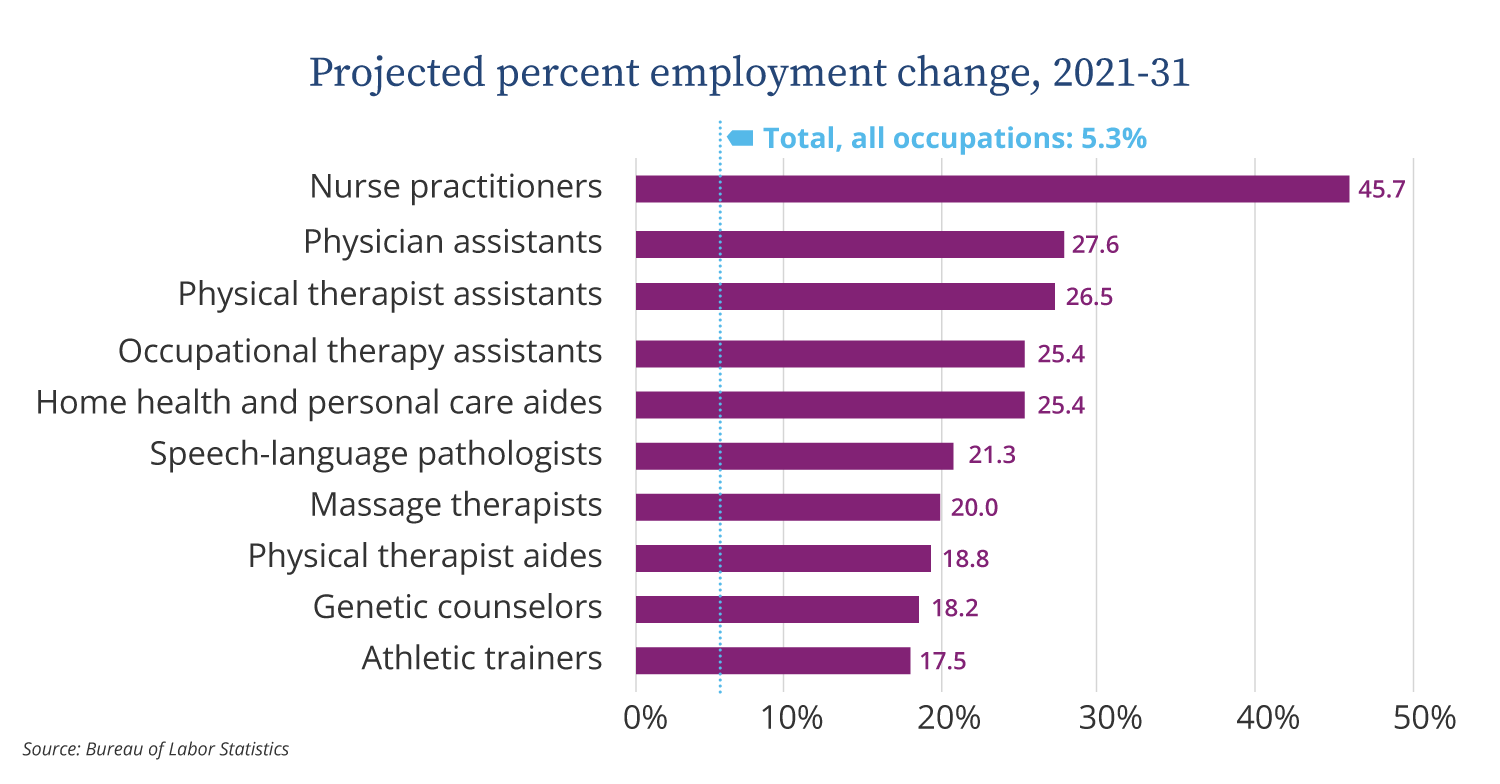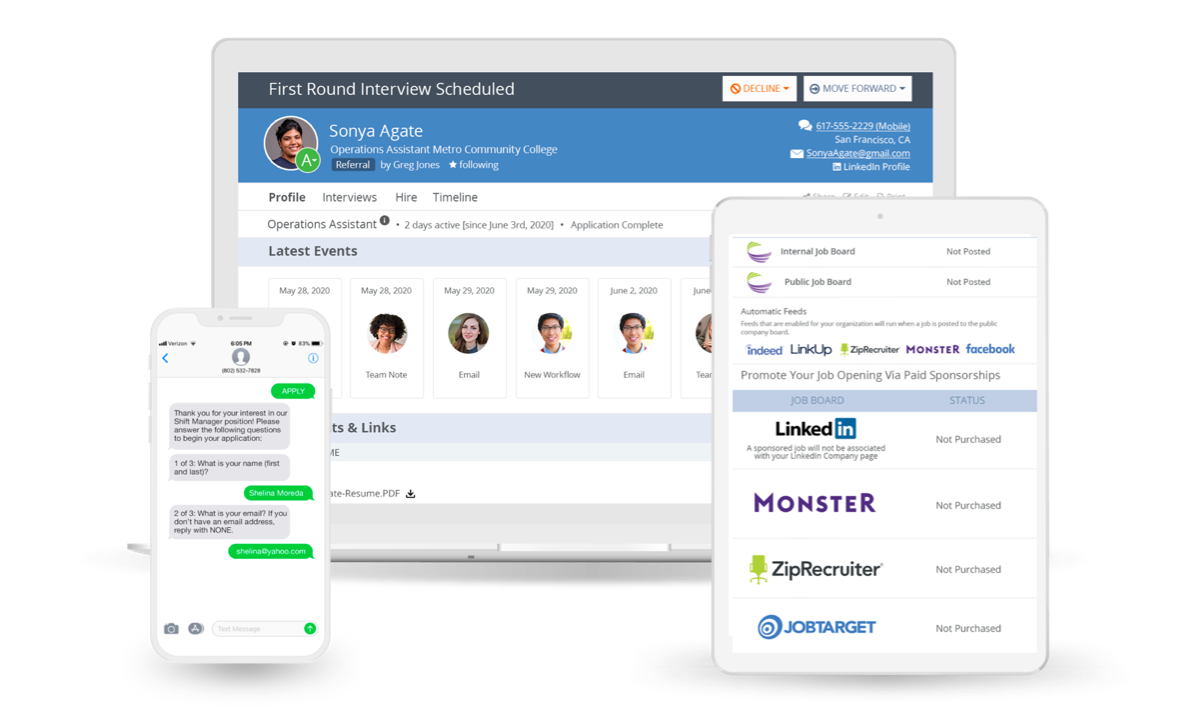No workforce went unscathed by COVID-19, but there’s no question that healthcare workers were the most heavily impacted. The industry didn’t lose the most jobs — 95% were recovered by July 2020 after an initial 8.2% dip. But the pandemic exacerbated challenges the healthcare industry was already dealing with, including worker shortages and higher-than-average burnout.
Between those challenges, workers’ increased risk of contracting the virus, and significant workload increases, it’s not surprising that one in five healthcare workers have quit since 2020. Today, the healthcare worker shortage is projected to last for at least the next decade. 47% of healthcare employees say they’re planning to look for a new job as burnout levels reach up to 70%.
So how can healthcare recruiters face these recruiting challenges head-on and fill positions quickly? And what part can technology play in attracting outstanding talent in the healthcare industry? Keep reading to find out.
Building a resilient healthcare team is more crucial than ever. 🤝🧑⚕ Discover proven strategies to tackle post-pandemic recruitment challenges and create a workforce that's ready for whatever comes next:Who Are Healthcare Workers?
Healthcare workers aren’t just doctors and nurses. They’re radiologists, janitorial staff, physical therapists, pharmacy techs, nursing assistants, EMTs, and more. Almost 15 million people were employed in healthcare in 2022, making the sector one of the largest employers in the U.S.
Why Is Healthcare Facing Recruitment Challenges?
While there are several reasons why healthcare is experiencing recruitment challenges, the most obvious one to focus on is post-pandemic burnout. Although burnout is nothing new in a sector with high work-related stress, the pandemic made it significantly worse. The level of burnout differs from position to position, but nurses reported the highest degree of burnout at 56%.
Work overload was found to be “significantly associated” with both burnout and intent to leave the profession. That means if a healthcare professional said they felt overworked, they were more likely to be dealing with burnout and more likely to say they were going to leave healthcare. It’s a vicious cycle, with heavy workloads causing burnout, leading to more employees quitting, thus increasing the workloads of the remaining employees.
Image sourced from healthsystemtracker.org
The Bigger Picture of Recruitment Challenges
Burnout isn’t the only challenge the healthcare sector faces over the coming years. Projections show the U.S. will be short 1.1 million nurses and up to 124,000 physicians over the next decade. The need for lower-wage positions will be even greater, with a shortage of 3.2 million workers in roles including home health aides and medical assistants.
These are a few more of the challenges recruiters and HR in healthcare are facing:
- Lack of qualified candidates: While there are recruitment challenges at every level of healthcare, the skills gaps are wider —and harder to fill — in highly skilled positions. The physician shortage in the US is so severe that the AAMC supports a bill to increase the number of Medicare-supported residency positions by 14,000 over seven years.
- Aging workforce: 45% of doctors are over the age of 55, and 40% will reach 65 —retirement age — in the next decade.
- Increasing demand for healthcare: As the population ages, life expectancies improve, and chronic conditions increase, the demand for healthcare will continue to rise. The Bureau of Labor Statistics (BLS) estimates there may be as many as 3.3 million new healthcare jobs by 2030.
- Education costs: Education costs for healthcare positions are extremely high. Students take on an average of $200,000 in debt to become MDs, a figure that rises dramatically if they choose to specialize.
- Hiring costs: It’s expensive to hire high-quality candidates. In addition to salaries, hiring costs include relocation expenses, benefits, contract signing bonuses, and the costs of the recruitment process itself.
- Decreasing budgets: From overall per capita decreases in spending to top-heavy administrations and prioritizing profits over people, the factors that decrease healthcare budgets leave hiring managers with less money to spend on the positions that actually matter.
- Staff retention: Healthcare sees some of the highest staff turnover rates of any industry, ranging from 19.5% in hospitals to a staggering 94% in nursing homes.
It’s clear that recruitment challenges will continue within healthcare for the foreseeable future. Understand these challenges and utilize modern strategies to win at hiring in this competitive market.
Image sourced from dol.gov
4 Tips for How to Meet Healthcare Recruitment Challenges
The difficult recruitment market doesn’t mean there are no available employees — but it does mean your HR and recruiting teams must work harder to fill open positions and make them stand out from other employers. What can recruiters do to make your company the most attractive option?
1. Make your brand stand out.
Recruiters need to develop a strong employer brand that shines through in your job descriptions, on your career site, and in interactions with recruiters. Your employer brand should show candidates why they should apply to your company and what makes you a great employer.
Does your company offer great training and development opportunities? Perks might also include flexible scheduling, overtime opportunities, or sign-on bonuses. If your company values set your organization apart, explain how.
Workers want to know how employers treat their staff on a personal level, and most will research a potential employer. Make sure your digital presence accurately reflects your employer brand.
🩺 Attract more candidates in the competitive healthcare sector with a strong employer brand that shows off the best parts of working at your company. Get 8 more healthcare recruitment tips:2. Highlight safety and support.
Healthcare workers on the frontlines were obviously at extremely high risk during the pandemic, which was often heightened due to a lack of safety measures and safety equipment. This means job candidates want to know what measures are in place should the pandemic return or another one emerge.
This is something you should both focus on and highlight. Revisit your safety protocols, such as wearing masks, providing PPE, and requiring all staff to be up-to-date with vaccination programs. Then, be sure to communicate ongoing measures to applicants and candidates.
3. Consider hiring contingent workers.
One way to tackle recruiting challenges is by hiring contingent workers. Hiring contingent workers gives you access to a wider pool of highly specialized talent as well as greater flexibility. You can fill vacancies faster without committing to a full-time hire. And if you do want contingent team members to transition to full-time employment, it’s far easier than sourcing a new candidate.
In some cases, you may have open remote administrative positions that could be filled by contingent candidates across the globe. With the best recruitment software and the right opportunity, you’re bound to attract lots of potential candidates.
4. Promote DEIB in the workplace.
A person’s gender, race, or sexuality does not affect their ability to do their job well. Despite women making up a majority of healthcare workers, there continue to be barriers to their career advancement, especially for women of color. People of color are also disproportionately affected by burnout.
A strong diversity, equity, inclusion, and belonging (DEIB) policy can help you remove those barriers, address burnout proactively, and stand out as an employer. Showing that you have a strong commitment to creating an inclusive workplace helps you attract the best-fit candidates. It can even be what pushes a candidate to accept an offer.
5 More Tips for Finding the Best Candidates in Healthcare
Recruitment teams are focused on one thing: finding the best candidate to fill positions. Whether you’re looking for an orthopedic surgeon or a nursing assistant, the candidate must have the right mix of qualifications and experience. They should fit into your company culture while also adding to it.
Here are a few more tips to remember as you source, recruit, and interview healthcare employees:
5. Think outside the box.
While some roles may require particular skills and experiences, others may need more general qualifications. Consider widening your net when looking for suitable candidates. Expand your talent pool to include groups like other areas of healthcare, soon-to-qualify medical students, and military veterans.
6. On-the-job training.
Upskilling and career development opportunities can increase staff retention and widen your talent pool. If a candidate ticks many boxes but falls short in a specific area, see if you can offer training to fill those skill gaps.
7. Benefits packages.
HR teams and recruiters should ensure that a job offer comes with a great benefits package. That can mean looking beyond standard retirement and health benefits and, especially in the wake of the pandemic, offering extra employee incentives such as mental health support, counseling, and peer support groups.
8. Expand your reach.
As well as looking overseas for suitable candidates, you should also expand your hiring process by partnering with nursing or medical schools.
9. Change your game plan.
You may need to change your traditional recruitment game plan to find and retain good candidates. HR teams need to embrace digital transformation — for example, using social media alongside traditional job ads or streamlining the candidate experience with an applicant tracking system. You can also explore strategies like employee referrals and nurturing passive candidates.
Better Hiring with Healthcare Recruiting Software
With the healthcare sector facing many recruitment challenges, your recruiting and HR teams need to refine your recruitment strategy and hiring tactics to attract and retain top talent. Those tactics can include adding a range of modern tools to your arsenal. Just as a company might choose the best software for payroll, you should be looking at software that can help with the recruitment process.
The best recruiting software for healthcare has the tools you need to deal with today’s hiring challenges:
- AI-assisted content creation so you can post job descriptions to multiple job boards, write candidate emails, and draw up offer letters faster than ever.
- Automatic interview scheduling links in recruiter emails to eliminate days of back-and-forth and screen candidates within days instead of weeks.
- Text message and mobile-accessible applications, candidate self-service portals, social sharing tools, and referral management to help decrease your time-to-hire for hard-to-fill positions.
Find out why ClearCompany is a leading Applicant Tracking System for healthcare organizations —sign up for a demo today.




